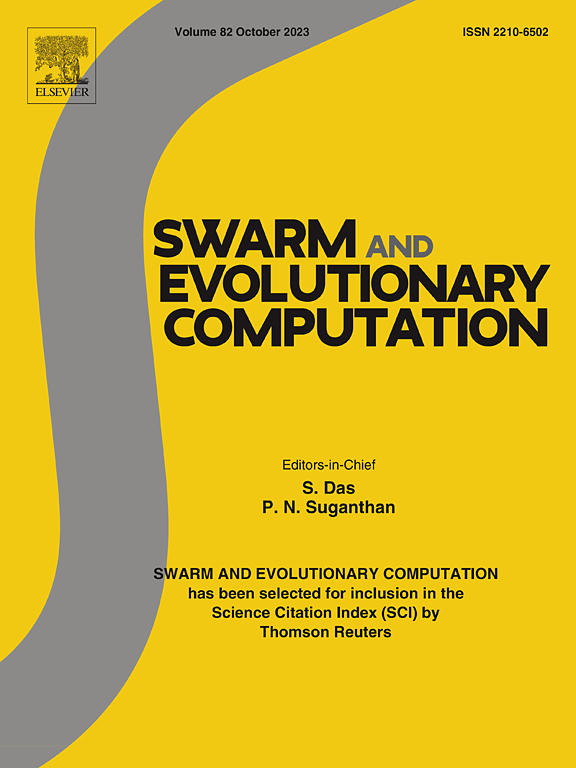卷积神经网络超参数优化的代理辅助小生境差分进化
IF 8.5
1区 计算机科学
Q1 COMPUTER SCIENCE, ARTIFICIAL INTELLIGENCE
引用次数: 0
摘要
深度卷积神经网络(cnn)中的超参数优化在提高模型性能方面起着至关重要的作用。然而,这些问题往往表现出固有的挑战,包括高维性、多模态、昂贵的评估和混合变量特征,这对优化算法提出了很高的要求。为了解决这些挑战,本研究提出了一种代理辅助小生境差分进化(SANDE)方法,该方法通过景观描绘、代理辅助优化和计算资源分配来有效地优化CNN架构超参数。具体来说,SANDE采用了一种集成决策空间和客观空间信息的小生境技术,将超参数景观划分为多个更简单、更有前景的子区域。然后使用代理辅助的集成差分进化有效地搜索这些子区域,其中混合差分进化和代理模型分别作为优化器和目标函数。为了提高优化的鲁棒性和收敛性,还引入了信息集成策略。在此基础上,引入了一种基于子区域历史优化结果的计算资源动态分配策略,实现了计算资源在子区域间的分配,提高了资源利用效率。将得到的sand -CNN与6个人工设计的CNN和14种高级CNN优化方法得到的23个CNN进行比较。实验结果表明,在有限的计算资源条件下,SANDE算法可以获得具有竞争力的性能。本文章由计算机程序翻译,如有差异,请以英文原文为准。
Surrogate-Assisted Niching Differential Evolution for hyperparameter optimization in Convolutional Neural Networks
Hyperparameter optimization in deep Convolutional Neural Networks (CNNs) plays a crucial role in enhancing model performance. However, such problems often exhibit inherent challenges, including high-dimensionality, multimodality, expensive evaluations, and mixed-variable characteristic, which impose high demands on optimization algorithms. To address these challenges, this study proposes a Surrogate-Assisted Niching Differential Evolution (SANDE), which efficiently optimizes CNN architecture hyperparameters through landscape delineation, surrogate-assisted optimization, and computational resource allocation. Specifically, SANDE employs a niching technique that integrates information from both the decision and objective spaces to divide the hyperparameter landscape into multiple simpler and promising sub-regions. These sub-regions are then efficiently searched using a surrogate-assisted integrated differential evolution, where a hybrid differential evolution and a surrogate model serve as the optimizer and objective function, respectively. An information integration strategy is also incorporated to enhance the optimization robustness and convergence. Furthermore, a dynamic resource allocation strategy is introduced to distribute computational resources across sub-regions based on their accumulated historical optimization outcomes, thereby enhancing resource utilization efficiency. The resulting SANDE-CNN is compared with six manually designed CNNs and 23 CNNs obtained by 14 advanced CNN optimization methods. Experimental results demonstrate that SANDE can achieve competitive performance at the cost of limited computational resources.
求助全文
通过发布文献求助,成功后即可免费获取论文全文。
去求助
来源期刊

Swarm and Evolutionary Computation
COMPUTER SCIENCE, ARTIFICIAL INTELLIGENCEC-COMPUTER SCIENCE, THEORY & METHODS
CiteScore
16.00
自引率
12.00%
发文量
169
期刊介绍:
Swarm and Evolutionary Computation is a pioneering peer-reviewed journal focused on the latest research and advancements in nature-inspired intelligent computation using swarm and evolutionary algorithms. It covers theoretical, experimental, and practical aspects of these paradigms and their hybrids, promoting interdisciplinary research. The journal prioritizes the publication of high-quality, original articles that push the boundaries of evolutionary computation and swarm intelligence. Additionally, it welcomes survey papers on current topics and novel applications. Topics of interest include but are not limited to: Genetic Algorithms, and Genetic Programming, Evolution Strategies, and Evolutionary Programming, Differential Evolution, Artificial Immune Systems, Particle Swarms, Ant Colony, Bacterial Foraging, Artificial Bees, Fireflies Algorithm, Harmony Search, Artificial Life, Digital Organisms, Estimation of Distribution Algorithms, Stochastic Diffusion Search, Quantum Computing, Nano Computing, Membrane Computing, Human-centric Computing, Hybridization of Algorithms, Memetic Computing, Autonomic Computing, Self-organizing systems, Combinatorial, Discrete, Binary, Constrained, Multi-objective, Multi-modal, Dynamic, and Large-scale Optimization.
 求助内容:
求助内容: 应助结果提醒方式:
应助结果提醒方式:


